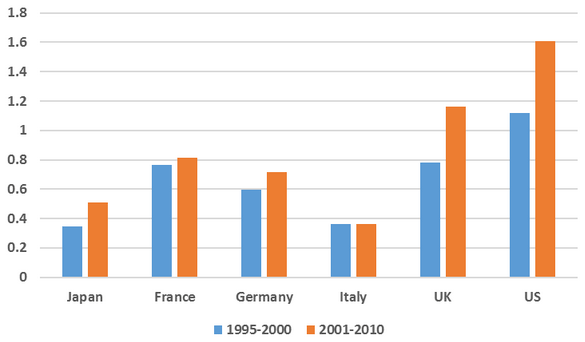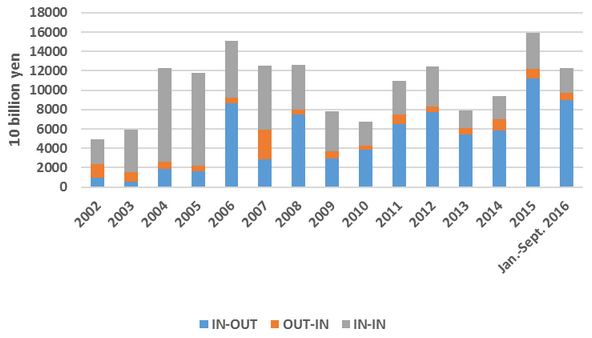Capital accumulation through capital formation is the key to realizing economic growth
Four years have passed since the launch of Abenomics. For any economic policy, perfect outcomes are difficult to achieve. In the case of Abenomics, while the target inflation rate has not been achieved within the set time frame, many economic indicators have returned to their levels prior to the 2008 global financial crisis, while the unemployment rate is lower and stock prices are higher than their pre-financial crisis figures. In the sense that there has been a recovery from the major slump that followed the global financial crisis, Japan's economic policy over the past four years has been successful.
However, from a different perspective, the statement that the Japanese economy has returned to its status prior to the global financial crisis is equivalent to saying that it has displayed no real growth since the crisis. Numerous commentators claim that a recovery in consumption is the key to raising the economic growth rate, but this way of thinking confuses business recovery and economic growth. For the realization of economic growth over the long term, capital accumulation through capital formation is more important than recovery in consumption. Unfortunately, as in the case of consumption, there has been no significant growth in capital formation over the past four years. Considering that capital equipment deteriorates over time, and that investment for the upgrade is required, there in fact has been no real increase in capital.
Increasing growth potential with investment in intangible assets such as knowledge and ideas as the axis
The government's aggressive monetary policy initially pushed real interest rates down, which should have increased capital formation. A weak yen and high stock prices provided a further boost. Why, then, despite these favorable conditions, has capital formation not increased sufficiently?
One of the many contributing factors is the narrow scope of the investment targeted for stimulus measures. The IT revolution occurring since the latter half of the 1990s has shifted the central player in corporate and socioeconomic development from tangible assets such as buildings and machinery to intangible assets such as software, knowledge, and ideas. Linking organically the existing capital facilities and the capital of this new concept are the driving force in improving productivity. Unfortunately, by looking only at capital formation as recorded in the gross domestic product (GDP), it is not possible to understand such change in investment concepts.
Of course, it will not solve the issues facing the Japanese economy only by adding investment in intangible assets up to the present. The GDP was revised higher by approximately 15 trillion yen following the recent addition of private investment in knowledge assets to the economy, and it remains insufficient if we consider investment in intangible assets on a broader scope. Figure 1 shows an international comparison of the ratio of investment in intangible and tangible assets. As the figure shows, investment in intangible assets exceeds investment in tangible assets in the United States and the United Kingdom, while in Japan the ratio is at only around 50%.

To put it the other way around, it suggests that there is some leeway for Japan to boost growth with investment in intangible assets at the core. Within intangible assets, Japan leads the United States and Europe in investment in research and development (R&D), but investment in the development of human resources (HR) and organizational reform has continued to decline since the collapse of the bubble. In fact, the limited investment in these areas is the cause of the recent slow growth in Japan's investment in intangible assets, and is also a factor in preventing the full leveraging of investment in IT and R&D.
"Work style reform" is an opportunity to review the direction for capital accumulation
Japanese companies recently have been attempting to supplement this shortfall in investment for the HR development and organizational reform through mergers and acquisitions (M&A) (see Figure 2). The continuing decline in investment in these areas over the quarter century since the collapse of the bubble has left Japanese companies with a lack of accumulated human resources within their corporate organizations. Acquiring existing organizations and human resources or increasing or deepening business partnerships in order to address this situation and strengthen profitability within a short period can be a rational strategy. However, if this strategy is to be continued into the future, it may no longer be possible to avoid structural reorganization as companies are now employing greater numbers of human resources with expertise in financial affairs and capital markets.

From this perspective, the government's "work style reform" efforts represent a tremendous opportunity to consider the direction for HR development and corporate organization over the long term. Put in another way, to the extent that work style reform is limited to issues such as working hours and the working environment, it will fail to contribute to growth strategy.
Bringing investment reform to the table in tandem with work style reform, through reconsideration of the type of investment that can assist in improving the working environment and ensure that corporate activities are maintained, will bring into perspective a path toward future corporate growth, and, beyond this, economic growth. We can hope that this year will see the first steps toward a review of the direction not merely for working styles, but also for capital accumulation.
* Translated by RIETI.
January 2017 Monthly Keidanren


